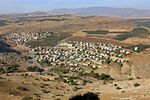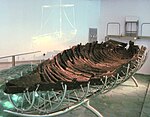Migdal, Israel
1910 establishments in the Ottoman EmpireAncient Jewish settlements of GalileeGerman diaspora in IsraelLocal councils in Northern District (Israel)Populated places established in 1910 ... and 1 more
Russian-Jewish culture in Israel

Migdal (Hebrew: מִגְדָּל, lit. Tower) is a town in the Northern District of Israel. It was founded in 1948, and granted local council status in 1949. In 2022 it had a population of 2,031. Migdal is located near Ginosar, and about 8 km north of Tiberias. It has a shoreline on the Sea of Galilee, including the Tamar, Ilanot and Arbel beaches.
Excerpt from the Wikipedia article Migdal, Israel (License: CC BY-SA 3.0, Authors, Images).Migdal, Israel
HaSheizaf, Migdal
Geographical coordinates (GPS) Address Nearby Places Show on map
Geographical coordinates (GPS)
| Latitude | Longitude |
|---|---|
| N 32.839077777778 ° | E 35.499294444444 ° |
Address
השיזף
HaSheizaf
1427943 Migdal
North District, Israel
Open on Google Maps









